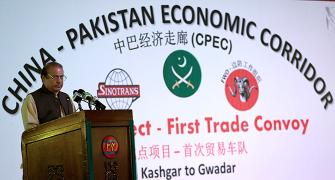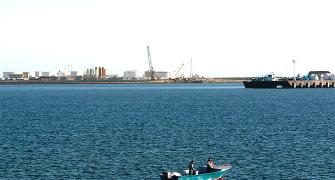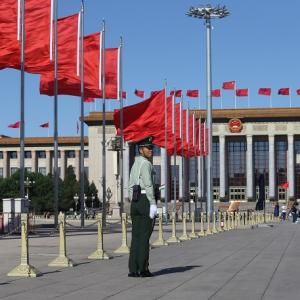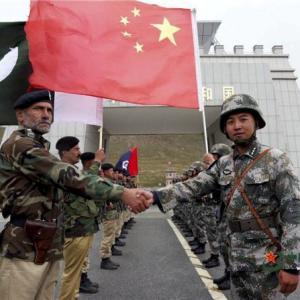The master plan reveals a far more expansive project involving Chinese penetration into Pakistan’s agriculture, industry, telecommunications, surveillance and intelligence networks and even leisure and popular culture. Ajai Shukla reports.

Pakistani English daily Dawn has published comprehensive details of the China-Pakistan Economic Corridor, a proposal that Beijing portrays as a vehicle for Pakistan’s development but which now appears as a thinly-disguised land grab that some in Pakistan already worry would compromise its sovereignty.
CPEC has so far been considered a road, rail and infrastructure link that links China’s remote northwestern Xinjiang province with Pakistan’s Gwadar port on the Arabian Sea.
The master plan, however, reveals a far more expansive project involving Chinese penetration into Pakistan’s agriculture, industry, telecommunications, surveillance and intelligence networks and even leisure and popular culture.
‘The plan envisages a deep and broad-based penetration of most sectors of Pakistan’s economy as well as its society by Chinese enterprises and culture,’ says Dawn, stating that the plan’s scope has no precedent in Pakistan’s history.
According to the plan, says Dawn, ‘thousands of acres of [Pakistani] agricultural land will be leased out to Chinese enterprises to set up ‘demonstration projects’ in areas ranging from seed varieties to irrigation technology.’
A full system of monitoring and surveillance will be built in cities from Peshawar to Karachi, with 24 hour video recordings on roads and busy marketplaces for law and order. A national fibre-optic backbone will be built for the country not only for internet traffic, but also terrestrial distribution of broadcast TV, which will cooperate with Chinese media in the ‘dissemination of Chinese culture’.
Dawn says: ‘One of the most intriguing chapters in the plan speaks of a long belt of coastal enjoyment industry that includes yacht wharfs, cruise homeports, nightlife, city parks, public squares, theatres, golf courses and spas, hot spring hotels and water sports.’
Recognising the insecurity across Pakistan, particularly in the insurgency-ridden northwest, there is a plan to build a ‘pilot safe city’ in Peshawar.
In dealing with industrialisation, the master plan trifurcates Pakistan into three zones, earmarking specific industries for each zone.
The western and northwestern zone, covering Balochistan and Khyber-Pakhtunkhwa, is marked for colonial-style resource extraction of chrome ore, gold, diamonds and marble.
The central zone is marked for textiles, household appliances and future cement clusters. This is puzzling, since the plan notes that Pakistan is already surplus in cement capacity.
Heavy industry is earmarked for the southern zone around Karachi and Gwadar ports.
Gwadar, which -- New Delhi worries -- could be used as a base for Chinese naval vessels, ‘is positioned as the direct hinterland connecting Balochistan and Afghanistan’.
The report notes that ‘some Chinese enterprises have started investment and construction in Gwadar” taking advantage of its ‘superior geographical position and cheap shipping costs to import crude oil from the Middle East, iron ore and coking coal resources from South Africa and New Zealand’.
According to the master plan, the CPEC ‘spans Xinjiang Uygur Autonomous Region and whole Pakistan in spatial range (sic). Its main aim is to connect South Xinjiang with Pakistan’.
The CPEC is divided into a ‘core area’ and ‘radiation zones’, which will feel the ‘knock on effects of the work being done in the core area’.
Listed in the ‘core area’ is ‘most of the Islamabad’s Capital territory, Punjab, and Sindh, and some areas of Gilgit-Baltistan, Khyber Pukhtunkhwa, and Balochistan’.
This is effectively most of Pakistan.
Dawn’s expose CPEC master plan revealed quotes from an original 231-page document, developed by Chinese experts and transmitted to Islamabad in June 2015. It is not possible to check the authenticity of the master plan.
According to the newspaper, ‘Chinese experts teams made multiple visits to Pakistan and Xinjiang during this period, drawing up a detailed picture of the situation in every area, prioritizing those that will come first, and identifying ‘hidden dangers’, bottlenecks and risks that should be anticipated along the way.’
On Sunday and Monday, China hosted a major conference on its One Belt, One Road initiative, of which the CPEC is a key part. Prime Minister Nawaz Sharif attended the conference, along with representatives from about a hundred countries.
India was a prominent absentee from the conference due to concerns that the CPEC, which passes through the Gilgit-Baltistan region of Pakistan-occupied Kashmir, infringes upon India’s sovereignty.
IMAGE: Pakistani Prime Minister Nawaz Sharif, left, meets Chinese President Xi Jinping ahead of the Belt and Road Forum in Beijing. Photograph: Jason Lee/Reuters










